
Pohnpei "upon (pohn) a stone altar (pei)" is an island of the Senyavin Islands which are part of the larger Caroline Islands group. It belongs to Pohnpei State, one of the four states in the Federated States of Micronesia (FSM). Major population centers on Pohnpei include Palikir, the FSM's capital, and Kolonia, the capital of Pohnpei State. Pohnpei Island is the largest (334 km2 [129 sq mi]), with a highest point (782 m [2,566 ft]), most populous, and most developed single island in the FSM.
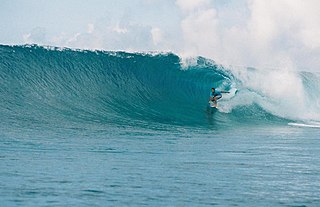
Palikir is the capital city of the Federated States of Micronesia located in the western Pacific Ocean. A town of slightly under 5,000 residents, it is part of the larger Sokehs municipality, which had a population of 7,000 as of 2009, out of the nation's total population of 106,487. It is situated on the northwest side of Pohnpei island, a high volcanic island surrounded by a fringing coral reef. Nearby to the northeast is the island's largest settlement, the coastal town of Kolonia. It was declared the capital of Micronesia in 1989.
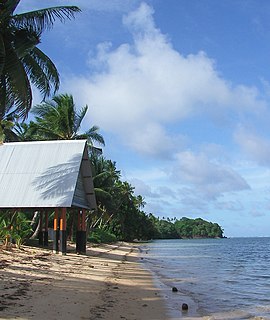
Babeldaob is the largest island in the island nation of the Republic of Palau. It is in the western Caroline Islands, and the second largest island in the Micronesia region of Oceania. Palau's capital, Ngerulmud, is located on Babeldaob, in Melekeok State.

Chalmette National Cemetery is a United States National Cemetery located within Jean Lafitte National Historical Park and Preserve in Chalmette, Louisiana. The cemetery is a 17.5-acre (7.1 ha) graveyard adjacent to the site that was once the battleground of the Battle of New Orleans, which took place at the end of the War of 1812. Despite its proximity to the site of the Battle of New Orleans in the War of 1812, the majority of the interments are of soldiers who were casualties or veterans of the American Civil War, the Spanish-American War, World War I, World War II, the Korean War, or the Vietnam War. The cemetery was subsequently closed to new interments.
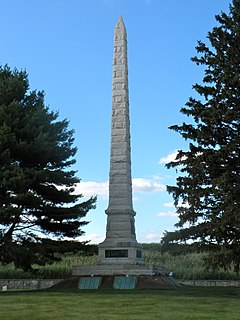
Finn's Point National Cemetery is a United States National Cemetery located in Pennsville Township, Salem County, New Jersey, United States. It encompasses 4.6 acres (1.9 ha), and as of February 2009, had 3,033 interments. Adjacent to Fort Mott, it is governed by the United States Department of Veterans Affairs and administered by the Washington Crossing National Cemetery.
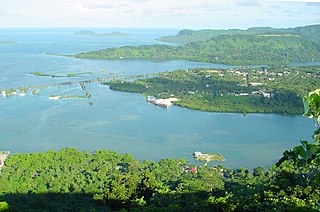
Kolonia is a coastal town and the capital of Pohnpei State in the Federated States of Micronesia (FSM). It was also the former FSM capital before being replaced by Palikir in 1989, located nearby to the southwest in the municipality of Sokehs. It has 6,074 people.

The Peshtigo Fire Cemetery is a cemetery in Peshtigo, Wisconsin. The cemetery is the burial location of the charred remains of victims of the Peshtigo Fire, of October 8, 1871, the deadliest natural fire in the history of the United States. Identified victims were buried in traditional marked graves, and over 300 unidentified victims were buried in a mass grave. The site is listed on the National Register of Historic Places. The memorial at the cemetery was the first official state historical marker authorized by the State Historic Society of Wisconsin. The cemetery is located adjacent to the Peshtigo Fire Museum, which is a memorial museum for the fire.
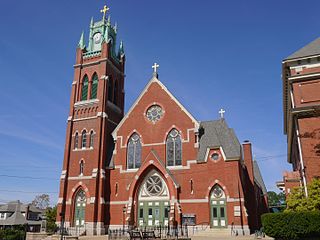
L'Église du Précieux Sang (also known as The Church of the Precious Blood is a historic Roman Catholic church complex at 94 Carrington Avenue and 61 Park Avenue in Woonsocket, Rhode Island, within the Diocese of Providence.
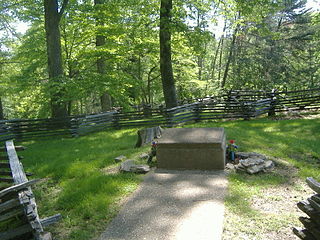
The Confederate Mass Grave Monument in Somerset in Pulaski County, Kentucky, near Nancy, Kentucky, honors the Confederate soldiers who are buried here who died at the Battle of Mill Springs. These soldiers were from Alabama, Mississippi, and Tennessee, and number over one hundred in total.

Sokehs rebellion was an uprising of the Sokehs tribe against local German rule that started on Sokehs Island off the main island of Pohnpei in the Eastern Caroline Islands in 1910/1911. The German district commissioner, Gustav Boeder, three other German officials and five islanders were killed by the rebels before German naval units arrived and restored order.

The Eastern Promenade is a historic promenade, 68.2-acre (27.6 ha) public park and recreation area in Portland, Maine. Construction of the Promenade began in 1836 and continued periodically until 1934. The 1.5-mile (2.4 km) park was designed by the Olmsted Brothers design firm and experienced its greatest expansion from the 1880s to the 1910s. The Promenade rings around the Munjoy Hill neighborhood and occupies the farthest eastern portion of Portland's peninsula. The Promenade is home to many historical sites, including a mass grave and the mast of USS Portland.

The Catholic Belltower is a historic tower at the Catholic Mission in Kolonia, on the island of Pohnpei in the Federated States of Micronesia. The belltower and adjoining masonry apse are all that remain of a church built in 1909 by German Capuchin missionaries, when Ponape and the other Caroline Islands were administered as part of German New Guinea. The rest of the church was destroyed during the fighting of World War II. The tower is 4.8 metres (16 ft) square, rising to a height of 20.7 metres (68 ft), and the shell of the apse is about 10 metres (33 ft) in height. The tower has a foundation of basalt rock and lime mortar, and is constructed out of concrete bricks.

The Oakland Cemetery is a 40-acre (16 ha) public cemetery maintained by the city of Fort Dodge, Iowa, United States. Property for the cemetery was set aside in 1859. It was laid out the same year by Egbert Bagg, an architect and civil engineer from Utica, New York. The graves and monuments are arranged around the natural contours of the hills that overlook Soldier Creek in a natural park-like setting. It is considered a good and rare example of a rural cemetery in North Central Iowa. It has been listed as an historic district on the National Register of Historic Places since 2000.

Deke Sokehs, or Sokehs Peninsula, is a mountainous peninsula on the north coast of Pohnpei in the Federated States of Micronesia. It was formerly an island, known as Sokehs Island, but it is now connected to the main island by causeway and a field of mangroves. The 1570-meter-long Dau Mwoakote Channel cuts through the mangroves, which, except in the west, is only a few meters wide.
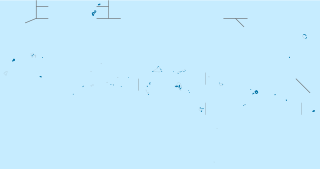
The Chief Agriculturist House is a historic house in Kolonia, the capital of Pohnpei State in the Federated States of Micronesia. It is a steel and concrete structure, built in the mid-1920s when Pohnpei and the other Caroline Islands were part of the Japanese South Seas Mandate. It was one of the highest-quality buildings constructed on Pohnpei during the Japanese administration, and was the home of the Japanese weatherman and agricultural overseer, said to be the second most powerful figure in Japanese Micronesia.

The German Cemetery is a historic cemetery in Kolonia, the capital of Pohnpei State in the Federated States of Micronesia. Pohnpei and the other Caroline Islands had become a German protectorate in 1899, after the Spanish–American War, and were administered as part of German New Guinea. This cemetery is a historical reminder of the period of German administration, although it was in deteriorated condition in 1976, accessible only by hiking through a mangrove swamp, with its wrought iron fence and gate in disrepair. Two German governors were buried here.

The Japanese Hydro-electric Power Plant is a former hydroelectric power generation plant and historic site in Kolonia, the capital of Pohnpei State in the Federated States of Micronesia. The site is historically and culturally important as a representative of three different eras in the island's history. The site is important in the culture of Pohnpei as a location of high-quality stones gathered for use in ritual ceremonies involving the pounding of kava and drinking preparations from the plant. In the early 1900s, when Pohnpei was administered as part of German New Guinea, the German administration established an experimental forest, planting a diversity of trees from around the world, some of which continue to thrive in the area. Finally, in the 1920s, during the Japanese South Pacific Mandate, a hydroelectrict facility was built here. When the property was listed on the United States National Register of Historic Places in 1976 the concrete power plant building and water catchment basin survived.

The Japanese Artillery Road and Pohndolap Area are a historic area on Sokehs Island in the Federated States of Micronesia. Sokehs has a prominent north-south ridge (known locally as "Pohndolap", overlooking the state capital Kolonia, and was fortified by the Japanese during World War II. They built a road to the summit area and emplaced anti-aircraft guns on the ridge. The ridge was also a key site in the 1910 Sokehs Rebellion against Japanese rule, and the remnants of a Pohnpeian fort are also in the area. The surviving elements of these fortifications were listed on the United States National Register of Historic Places in 1976. The old road is now part of a hiking trail, leading up to the fortifications.

The Spanish Wall is the deteriorating remnant of Spanish Fort Alphonso XIII in Kolonia, the capital of Pohnpei State in the Federated States of Micronesia. When built, the wall was about 0.5 miles (0.80 km) in length and 8 feet (2.4 m) in height with a parapet that ranged in height from 2–3 feet (0.61–0.91 m). The wall was built by Spanish administrators of Pohnpei in 1887 after a local uprising drove the local Spanish authorities onto a ship in the harbor. Most of the wall was taken down by the German administration that took over in the early 20th century, after the Spanish–American War. The remains of the wall, about 700 feet (210 m) and two arches, are now part of a local park.

The Japanese Elementary School for Ponapean Children is a historic school building in Kolonia, the capital of Pohnpei State in the Federated States of Micronesia. The surviving building is one of two reinforced concrete buildings, constructed c. 1920-21 by the Japanese authorities of the South Seas Mandate, which included the island of Pohnpei, then known as "Ponape". These buildings were the sole educational facility on the island for native children, those of Japanese dependents attending a separate, segregated facility. They were heavily damaged by bombing during World War II, with one of them being demolished and the other restored for use as part of the island's hospital.















